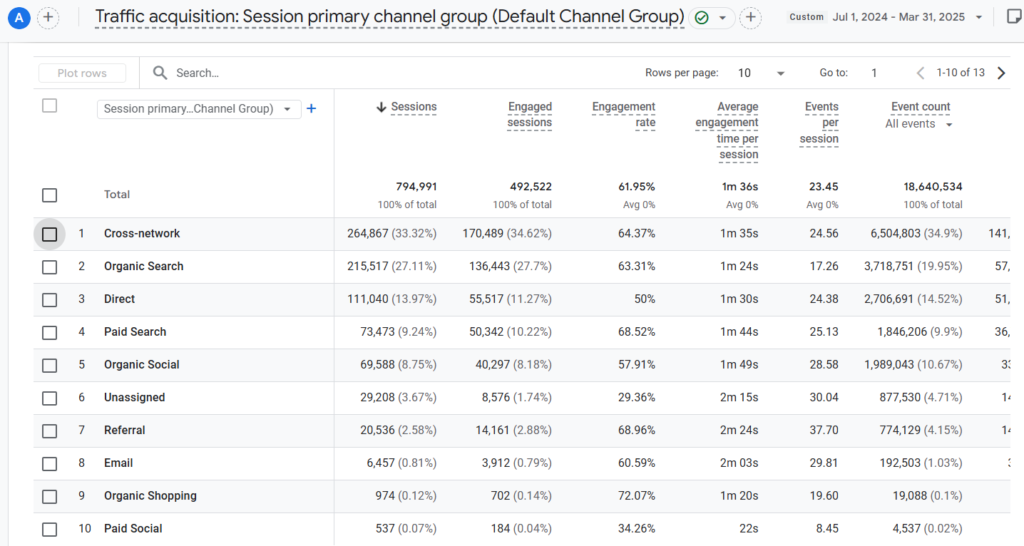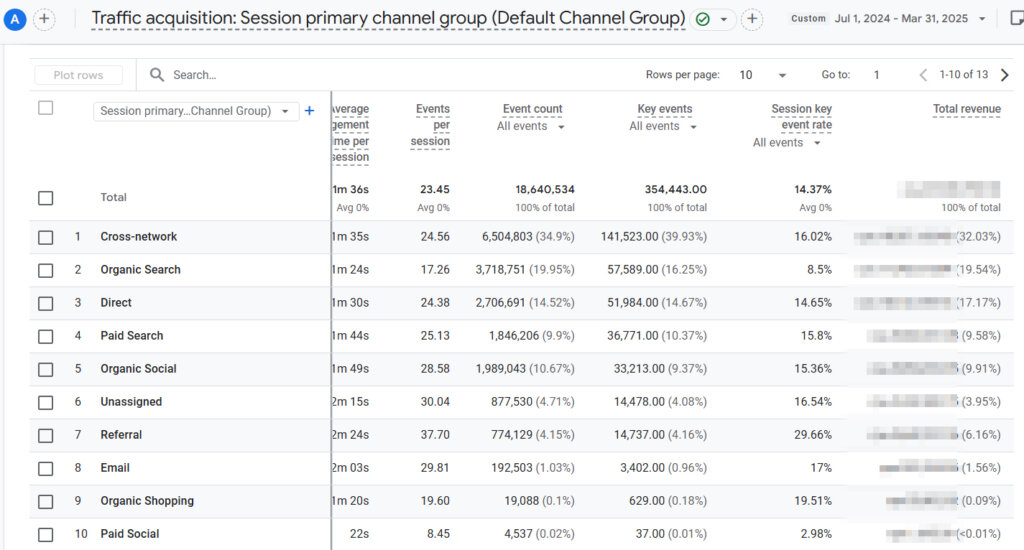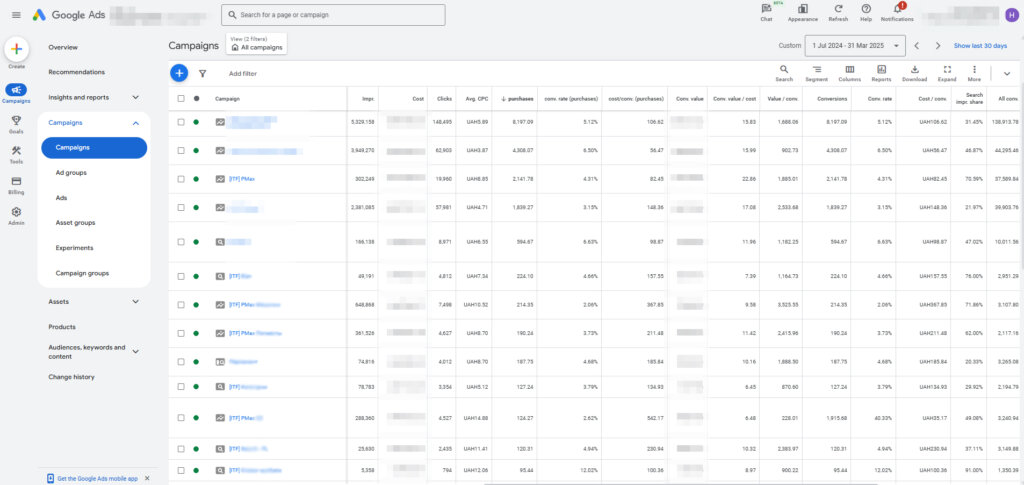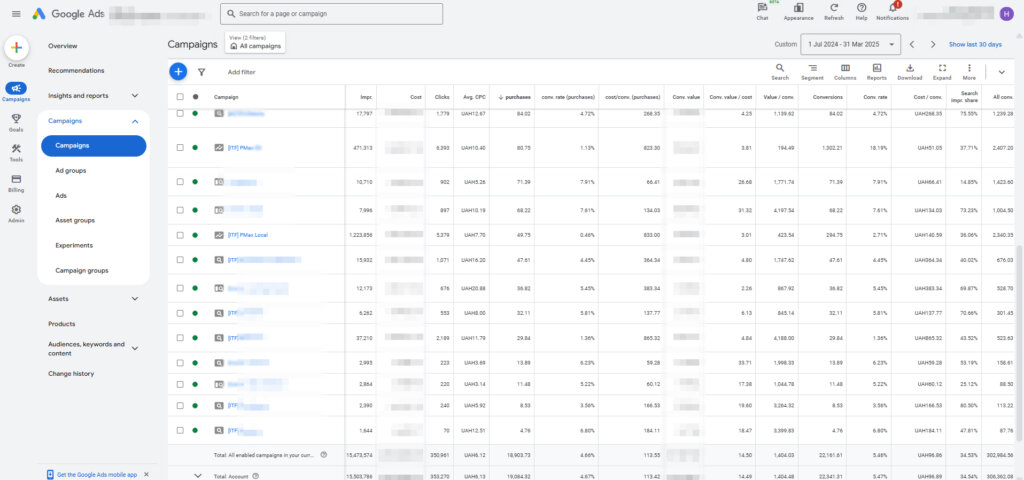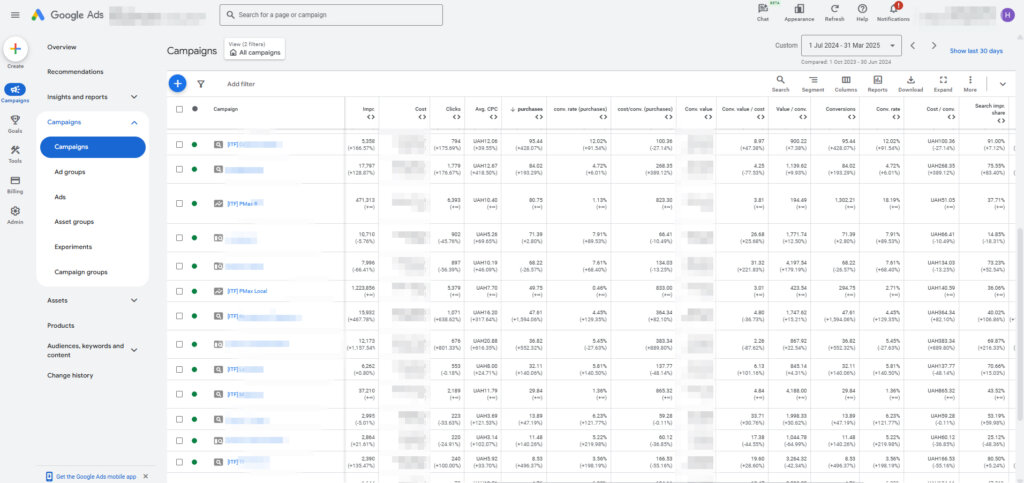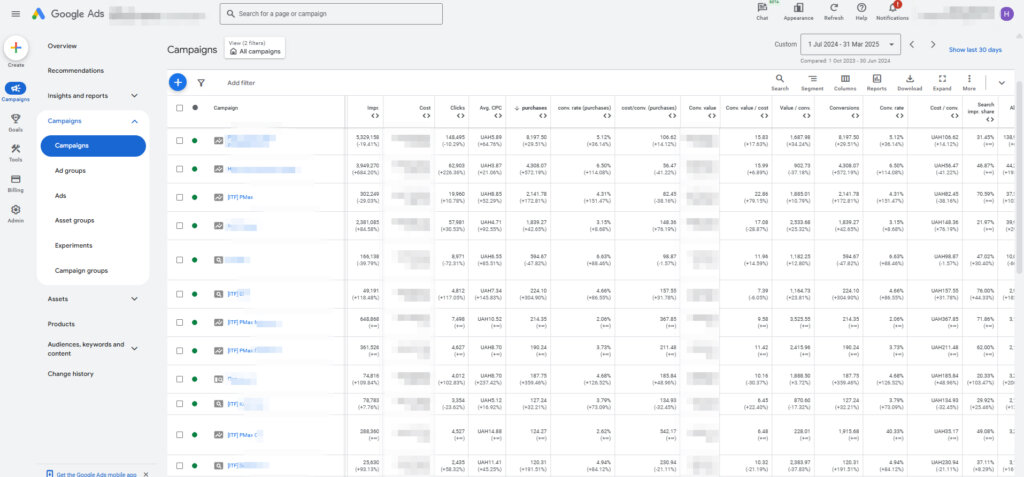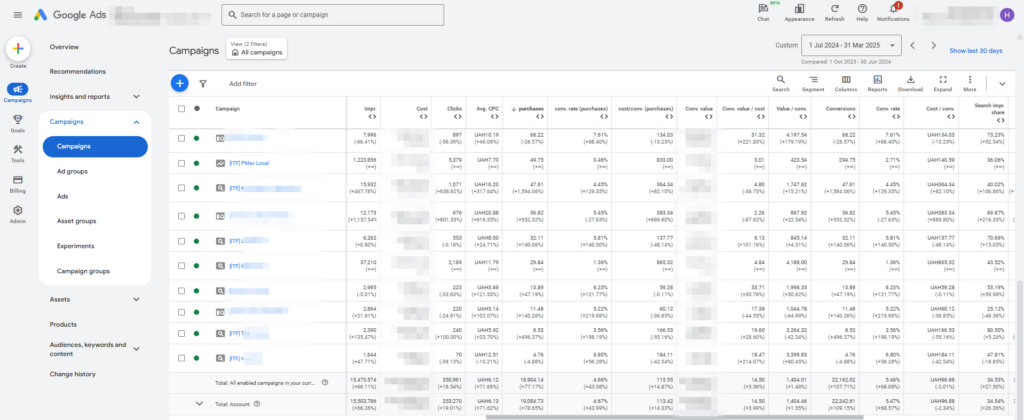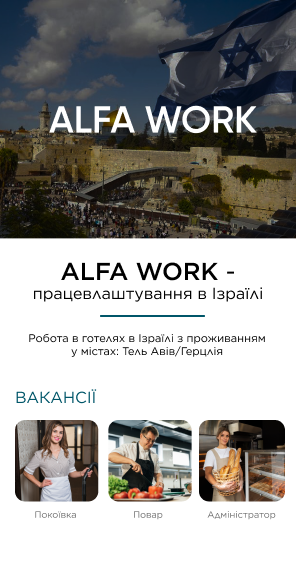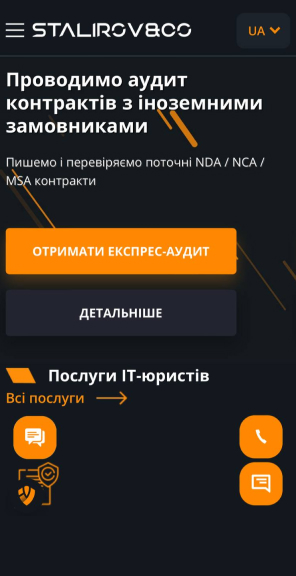PMax and Google Shopping for a website on the Horoshop platform

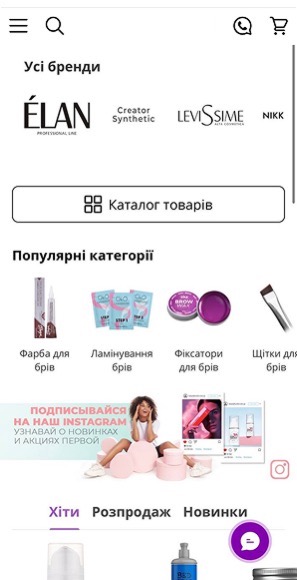

In this case, we worked on setting up advertising for a website built on the Korhop platform, which has its specifics when configuring Google Ads campaigns. Notably, this platform typically ensures a stable URL structure and automatic product feed generation, which significantly simplifies launching and optimizing Google Shopping and Performance Max campaigns. Additionally, Korhop’s integration often facilitates conversion tracking setup via Google Tag Manager (GTM), ensuring accurate data transmission for purchases and other key actions. This enables effective use of automated bidding strategies based on data to achieve target profitability metrics.
About the Client
A specialized online store offering a wide range of professional cosmetics, primarily targeting beauty industry professionals such as brow artists, makeup artists, and lamination specialists. Approximately 99% of the client’s audience are women, which shapes the marketing strategies and product assortment.
The client approached ITForce intending to increase sales volume while maintaining target profitability metrics. Our key performance indicator is a target ROAS exceeding $10, ideally within the $13–14 range. At the same time, the optimal cost per conversion is set at $2–3 to ensure maximum advertising campaign efficiency.
Workflow
The collaboration with the client began with an audit of the account and campaigns, based on which we provided the client with recommendations.
Post-audit recommendations:
- Add headlines to responsive search ads emphasizing numeric benefits and clear calls to action (CTAs) to improve ad quality scores where possible.
- Diversify descriptions of sitelinks so users receive more information about the store’s or product’s advantages.
- Analyze search queries and expand the negative keyword list based on irrelevant queries.
- Add audiences to the Observation based on system recommendations.
- Use the “presence” type of geo-targeting if there is no need to reach users outside specified locations. In the case of Ukraine, it’s also advisable to target specific regions to exclude locations where orders cannot be accepted.
- Add Image Extensions and remove disapproved ones.
- Follow a consistent formatting principle in ad copy and extensions, avoiding unjustified use of uppercase letters.
- Pause keywords, ad groups, or products with low performance or high cost per result.
- Check the website and feeds for compliance with policies: presence of ad overlays on images, correct translation, accessibility of landing pages, etc.
- Avoid using the same products for targeting in multiple campaigns.
- Standardize delivery terms on product pages and corresponding sections to prevent account suspension.
- Add new keywords to ad groups without keywords if relevant, or pause them.
- Publish content on the website, including banners, according to language versions. Check the content for errors.
- Set up click tracking on phone numbers, WhatsApp, Viber, etc., if orders are received through these channels.
The first changes in the account were implemented in December 2023. During the setup phase, we created new campaigns:
- search campaigns (with branded and broad keywords)
- Performance Max campaigns
Next, we updated ad copy, expanded the negative keyword list, verified the accuracy of conversion data transmission, and configured micro-conversion tracking. Additional technical adjustments were also made.
Campaign performance during the first month of project management:
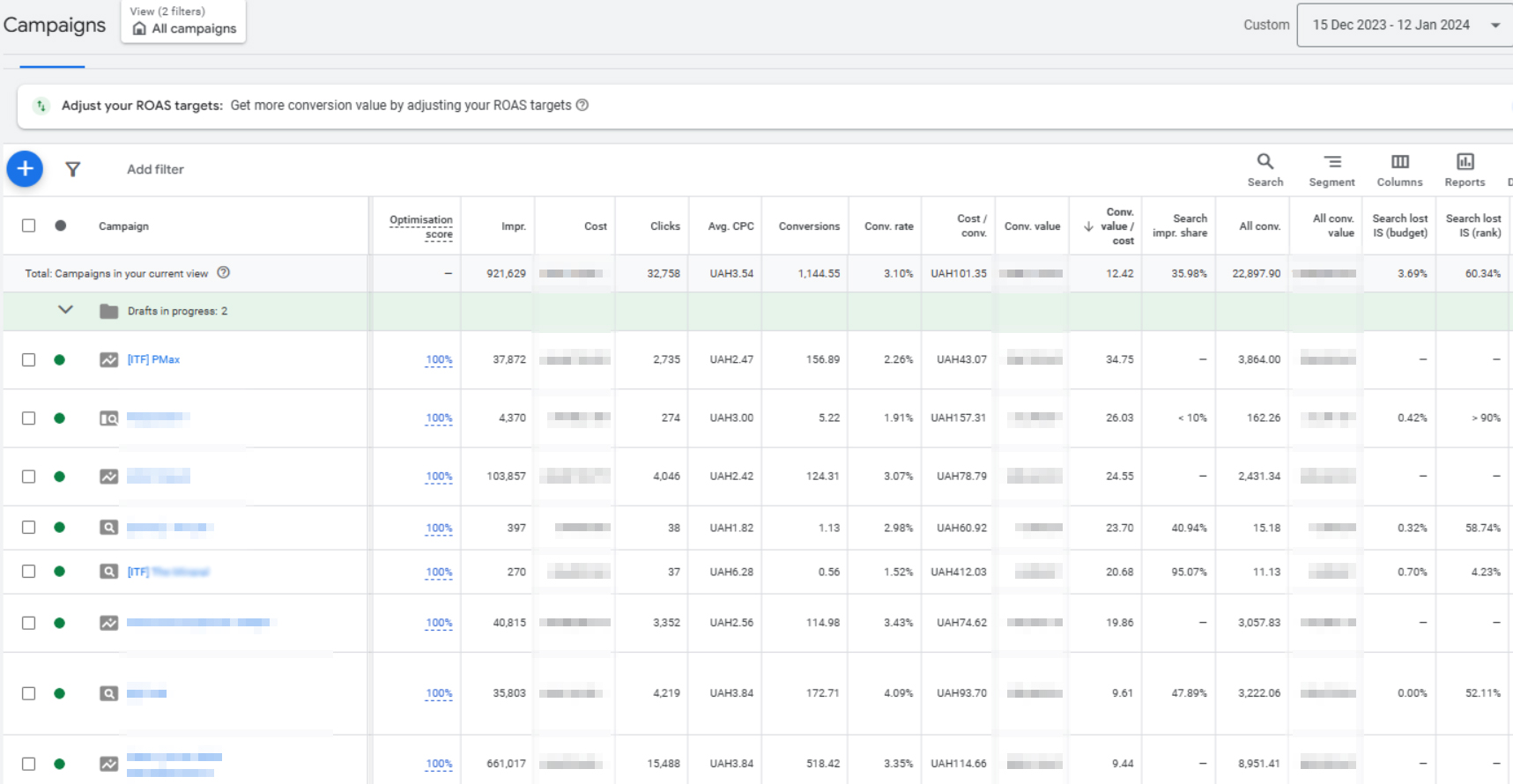
Fig. 1 - Campaign performance during the first month of project management
The advertising campaigns generated a high volume of impressions and clicks, indicating active engagement and audience reach. The configured ads delivered 1,144.55 conversions. The conversion rate stands at 3.10% with 3% of clicks resulting in conversions, which is a strong outcome. A high ROAS of 1,242% demonstrates excellent return on investment, meaning every 1 UAH spent brought the client over 12 UAH in revenue on average. This highlights the high efficiency of the advertising efforts. The cost per conversion is moderate at 101.35 UAH, aligning with the profit margins typical for the health and beauty niche. Importantly, such a cost per conversion is accompanied by a very high ROAS, confirming the profitability of the ad investments.
However, there is a significant impression share loss due to budget constraints - 60.34%. This means over half of potential impressions (and consequently clicks and conversions) are lost because of limited budget. This indicates considerable untapped potential for campaign scaling and further revenue growth. The low impression share loss due to rank, at 3.69%, is a positive sign, suggesting that ad quality and bids are sufficiently high. Most impression losses are budget-related rather than due to low ad rank. As a result, we continued to optimize and scale the current campaigns.
Notably, for Performance Max, we proposed to the client to exclude only those brands that were underperforming (the client already had several PMax campaigns set up). After approval, by the fourth week of the new campaign it showed the lowest cost per conversion and the best “conversion value/cost” metric in the account.
- 156.89 total conversions
- 34.75 ROAS - an exceptionally high return on investment, indicating a highly effective campaign
- 48.07 cost per conversion - the lowest among all campaigns with conversions, which is very positive
Thus, the Performance Max campaign demonstrates high efficiency, generating significant revenue at a low cost per conversion.
In March 2024, the client provided us with a list of competitors, which was identified as a priority task at that time. Our main focus was on competitor brands in the "Permanent" category. Currently, two active search campaigns in the account target queries related to these brands.
Later, at the client’s request, we set up a search campaign targeting Poland for key categories, as well as a competitor brand search campaign targeting Ukraine.
Summary of tasks completed in the account during the first month of collaboration:
- Setting up search campaigns by product categories and brands: developing a structure and selecting keywords
- Launching a Performance Max campaign focused on selected brands
- Adding ad extensions: clarifications, additions, and links to website pages
- Diagnosing technical issues on the website and compiling a list of recommendations
Correcting textual errors and inaccuracies in ads and extensions (e.g., “free delivery from 999/1000 UAH”), adding new headlines and descriptions to improve ad relevance and quality - Pausing ad groups without active keywords
- Adding audiences to “Observation” mode based on system recommendations for further performance analysis
- Removing disapproved extensions (including images) to maintain account cleanliness.
- Adding negative keywords based on analysis of irrelevant search queries to avoid showing ads for non-relevant searches.
- Submitting appeals for extensions whose delivery was restricted due to policy violations.
- Excluding low-performing inventory (ads, ad groups, products) that consumed budget but did not generate conversions.
- Configuring event tracking in GA4 reports, including clicks on phone numbers, emails, Telegram, Viber, and WhatsApp
- Verifying the accuracy of purchase event value transmission to ensure correct ROAS reporting and advertising performance analytics.
Client-approved campaign structure:
- The search campaign by categories is implemented as a single, broad campaign covering keywords related to the main product lines.
- Brand search campaigns are organized as separate campaigns for each brand (“one campaign = one brand”) to allow more precise bid control and performance management.
- Performance Max combines low-performing brands (based on statistics from existing campaigns and brands) into a single consolidated campaign, with individual asset groups created for each brand within it.
The project was then paused for several months until the client resumed activities in early July 2024. At that time, the client set new objectives for paid search:
- create a new Performance Max campaign for priority product categories
- update ad copy by creating new texts in Ukrainian
launch Shopping campaigns targeting new geographies - assess the overall account situation
As a result of the analysis, we set up Shopping campaigns for Romania and the Czech Republic, created a new Performance Max campaign without creatives for priority product categories, updated ads, expanded the keyword list, adjusted bidding strategies, and more.
Working on campaigns for the Czech Republic and Romania
The main focus of these campaigns is to gather data from active campaigns, particularly tracking the “Purchase” event and increasing conversion volume, while prioritizing improved return on ad spend. Subsequently, we transitioned to a tROAS bidding strategy.
Currently, the cost per conversion remains high, but as sufficient data accumulates, low-performing products are gradually excluded from serving to optimize spending and improve results.
Consent mode setup for advertising in EEA countries
Obtaining user consent for cookie usage is a mandatory requirement for countries in the European Economic Area (EEA), including Poland, Germany, Romania, the Czech Republic, and others. According to GA4 reports, approximately 21% of all site visitors come from the EEA, representing a significant portion of the audience.
Google experts recommend implementing consent mode based on geolocation, as this requirement is currently not mandatory for Ukraine. Consent banner display functionality limited to selected geographies is supported by services like Cookiebot. Besides Cookiebot, custom solutions involving developers can also be implemented. However, this approach may pose risks of technical errors and subsequent issues with analytics, especially since the client’s team lacked web analytics specialists, which complicates the timely detection and resolution of potential failures.
Additionally, user consent mode is a mandatory condition for using enhanced conversion tracking. This tool helps minimize data loss regarding conversions under strict privacy compliance requirements. Google reserves the right to audit advertisers for policy compliance and may suspend accounts and restrict product access in cases of repeated violations or failure to meet requirements.
Considering all these aspects of the importance of implementing consent mode, we recommended that the client complete the consent mechanism rollout proactively—before any issues arise—rather than relying on chance.
In our opinion, the optimal solution would be to use a Consent Management Platform (CMP), as such platforms automate a significant portion of the process. Although these services are typically paid for larger websites (for example, Cookiebot costs up to €50/month), they offer extensive customization options: banner design, language selection, display logic, and more. Installation is done via Google Tag Manager (GTM), and we could handle this implementation on our side.
Our client had two options for implementing consent mode:
- Using existing CMP integrations (e.g., Cookiebot). In this case, the client manages banner content, appearance, and settings via the Cookiebot dashboard. We create a new CMP template tag in GTM, specifying the Cookiebot ID (obtained from the client’s dashboard) and deploy the banner across all website pages, taking regional settings into account.
- Implementation according to a technical specification involving a developer.
Cookiebot платний, але з ним нічого не потрібно кодувати вручну. У другому випадку всі питання реалізації лягають на клієнта, включаючи впровадження режиму згоди на Хорошоп. Наразі рішення щодо вибору інструменту для впровадження режиму згоди знаходиться на стороні клієнта.
Conversion events
Currently, the account runs search and Performance Max campaigns. The primary conversion event in the account is Purchase (since September, this event is sent directly from the website; prior to that, a similar event was imported from GA4). For the Performance Max campaign shown in Odesa (where the client has a pickup point), Google Maps impressions are enabled, along with click events for route building.
For campaigns targeting Romania and the Czech Republic, in the early stages, Add to Cart and Checkout events were also included in the “Conversions” column alongside Purchase events to accelerate the learning process of bidding strategies.
Summary of setup and optimization tasks carried out during the collaboration with the client.
Analytics and recommendations:
- Report analysis. Formulation of recommendations.
- Implementation of system recommendations.
- Search query analysis.
Campaign optimization:
- Adjusting bidding strategies
- Adjusting and reallocating campaign budgets
- Updating targeting themes for Performance Max
- Excluding products/product groups with low conversion value from serving
- Improving the quality scores of responsive search ads
- Removing images restricted from serving (Performance Max)
- Adding excluded placements
Keywords and semantics:
- Adding new keywords
- Adding and expanding the negative keyword list
- Expanding semantics upon agreement
- Pausing or excluding outdated/ineffective keywords and search queries
- Pausing keywords with no impressions
- Excluding low-performing search queries
Ads and extensions:
- Updating ad copy
- Adding new or pausing outdated ad extensions
- Submitting appeals for disapproved ads or those with serving restrictions
Ad groups/campaigns:
- Pausing or excluding low-performing ad groups
- Pausing outdated or underperforming campaigns
- Setting up new campaigns (search, Shopping, Performance Max) upon request or approval
- Adding new asset groups to Performance Max
- Pausing groups without active keywords or conversions
Products (Google Merchant Center/PMax):
- Submitting products and disapproved products for manual re-review
- Excluding products with a high cost per conversion or no conversions
Audiences and targeting:
- Adding audiences to Observation (including system recommendations)
- Updating targeting by product groups (including after feed changes)
- Updating language targeting settings
Events and conversions:
- Editing events counted in the “Conversions” column at the campaign level
- Removing outdated conversion events from Google Ads
- Configuring purchase event data transmission from the website
Technical support/diagnostics:
- Diagnosing violations or discrepancies on the website or in accounts
Niche and project specifics
The client operates in a competitive and dynamic segment characterized by pronounced seasonality, a wide product range, and a diverse target audience. Buyers can be either end consumers purchasing individual items priced around 300 UAH or professionals buying materials in bulk starting from 4,000 UAH and up.
Advertising campaign strategy:
- Launched a “local” Performance Max campaign emphasizing same-day order pickup as a key advantage.
- Separate campaigns are set up for priority product groups.
- Implemented individual campaigns for different markets: Ukraine, Poland, the Czech Republic, and Romania.
- Utilized search campaigns with branded keywords, including product names and competitor brands.
The client is open to suggestions and recommendations; however, the implementation of changes is carried out on their side, as the client’s team has its resources, such as developers, designers, an SEO specialist, a marketer, etc. As a result, we have a multi-stage approval and implementation process that requires additional time to execute specific initiatives.
Google Ads performance results
We have been collaborating with the client for an extended period and consistently achieve key performance indicators (KPIs), occasionally even exceeding planned targets.
Specifically:
- The client’s account ROAS maintains a level above 1000%, and during some periods reaches 1300–1400%, aligning with the client’s target expectations.
- The cost per conversion remains within the $2–3 range, which is optimal for this niche.

Fig. 2 - Cost and ROAS for the entire collaboration period
Going forward, to ensure data relevance, we will consider periods following the resumption of collaboration, starting from July 2024.
Traffic channels
Sources driving traffic to the client’s website.
Fig. 3 - Driving traffic to the site
Contextual advertising channels (Cross-network, Paid Search) are the largest source of traffic to the client’s website, accounting for 42.56% of total visitors and 41.61% of total revenue.
- 794,991 total sessions
- 492,522 total engaged sessions
- 61.95% overall engagement rate
- 1.36 minutes average engagement time per session
- 23.45 events per session
- 18,640,534 total events
- 354,443 total key events
- 14.37% overall key event rate per session
Regarding the share of key events from the CPC channel:
- 39.93% from Cross-network (engagement share 64.37%)
- 10.37% from Paid Search (engagement share 68.52%)
Cross-network is the most effective and dominant channel, delivering a significant volume of traffic, conversions, and revenue:
- leader in sessions (33.32%) and engaged sessions (34.62%)
- generates the largest share of key events (39.93%)
- leads in total revenue (32.03%)
The channel has an average engagement time per session of 1m 35s, close to the overall average, confirming its effectiveness.
Paid Search is a highly effective channel that delivers quality, engaged traffic with strong conversion rates:
- significant traffic volume (9.24% of sessions)
- high share of key events (10.37%)
- substantial contribution to revenue (9.58%)
- highest engagement rate (68.52%) among all channels and a high number of events per session (25.13)
Paid Search demonstrates a very good average engagement time per session (1m 44s), even exceeding the overall average. This indicates high relevance of the ads to user queries, with users finding exactly what they were searching for.
Contextual advertising (specifically Cross-network and Paid Search channels) is undoubtedly the most effective source of customer acquisition for this project, delivering the highest volumes of conversions and revenue with a strong return on investment.
Overall performance of contextual advertising over 9 months of collaboration
- 22,341.31 total conversions in the account
- 19,084.32 Purchase conversions
- 14.49 ROAS (1,449%)
- 5.47% conversion rate
- 96.89 UAH cost per conversion
- 6.13 UAH average cost per ad click
Key takeaways from overall advertising performance:
- The substantial number of purchase conversions - 19,084.32 - indicates that the campaigns generated a large volume of target actions over 9 months, averaging approximately 2,120 purchases per month. This is a strong result considering the niche specifics.
- A ROAS of 1,449% - exceeding the expected KPI of 10+ - demonstrates consistently high advertising profitability.
- The average cost per conversion of 96.89 UAH falls within the target range ($2–3), confirming the effectiveness of the setup and budget control.
The campaigns have significant scaling potential, and increasing the budget is likely to yield even greater revenue while maintaining a high ROAS.
Comparison of Advertising Periods (01.07.2024–31.03.2025 / 01.10.2023–30.06.2024):
- +109.15% increase in total conversions
- +71.65% increase in purchase conversions
- -2.34% decrease in average cost per conversion
- +14.33% increase in cost per purchase conversion
- +68.57% increase in conversion rate
- +104.25% increase in advertising spend
The total volume of target actions doubled (+109.15%), reflecting campaign scaling and quality improvements in advertising. Website traffic is generating significantly more target actions (+68.57% increase in conversion rate), indicating higher quality keywords, ads, and more. Although the cost per purchase slightly increased (+14.33%). This is acceptable against the backdrop of overall purchase growth. The average cost across all conversion types decreased by 2.34%, showing that campaign optimization was effective. Advertising budget more than doubled, which is reasonable given the proportional increase in conversions and revenue (+112.39% in ad revenue).
Among purchase conversions, the Performance Max campaigns are the most effective, delivering 8,197.5 purchase conversions with a 29.51% increase. The competitor-focused campaign showed outstanding results, with a purchase increase of 1,594.06%.
The advertising campaigns have significantly boosted sales volume and overall effectiveness, especially improving the conversion rate, which is a key quality indicator. Most campaigns demonstrate considerable growth in impressions, clicks, and most importantly, conversions and their value. The average cost per click (CPC) varies across campaigns, rising in some and falling in others, depending on competition and bidding strategies. Importantly, any increase in CPC is often offset by higher conversion rates and ROAS. Many campaigns have shown improved ROAS, reflecting efficient ad spend optimization and enhanced profitability. The increased spend is justified, as it corresponds with a rise in purchases and total conversions. The average cost per conversion remains within target ranges, indicating a positive overall trend. The client’s KPIs are being fully achieved.
Throughout our collaboration, we actively enhanced the quality of advertising materials, including ads and extensions. We also launched a number of new campaigns timed for key promotional periods such as Black Friday, the company’s anniversary, and Cyber Monday. A crucial step was identifying priority products and those with low performance for further optimization.
We completed gathering and approving the semantic core with the client for an upcoming search campaign focused on wholesale and dropshipping. Currently, we are waiting for the client to prepare the corresponding landing page and finish website updates.
Ready to take your business to the next level? Contact us to order PPC Advertising!
